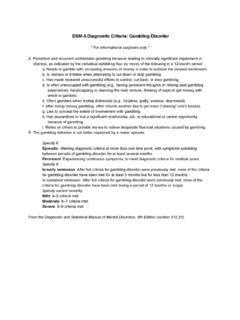Transcription of DSM-5 CliniCal DiagnoStiC Criteria for opioiD USe DiSorDer1
1 DSM-5 CliniCal DiagnoStiC Criteria for opioiD Use DiSorDer1 . To be eligible for methadone, buprenorphine/naloxone or slow release oral morphine agonist treatment, patients must meet DSM-5 Criteria for opioiD use disorder. DSM-5 Criteria for opioiD Use Disorder 1 Opioids are often taken in larger amounts or over a longer period than was intended 2 There is a persistent desire or unsuccessful efforts to cut down or control opioiD use The presence 3 A great deal of time is spent in activities necessary to obtain the opioiD , use the opioiD , of at least or recover from its effects 2 of these symptoms 4 Craving or a strong desire to use opioids indicates an opioiD Use Disorder 5 Recurrent opioiD use resulting in a failure to fulfill major role obligations at work, school, (OUD).
2 Or home The severity 6 Continued opioiD use despite having persistent or recurrent social or interpersonal of the OUD is problems caused or exacerbated by the effects of opioids defined as: 7 Important social, occupational, or recreational activities are given up or reduced MILD: because of opioiD use The presence 8 Recurrent opioiD use in situations in which it is physically hazardous of 2 to 3. symptoms 9 Continued use despite knowledge of having a persistent or recurrent physical or MODERATE: psychological problem that is likely to have been caused or exacerbated by opioids. The presence of 4 to 5. 10 Tolerance,* as defined by either of the following: symptoms a) Need for markedly increased amounts of opioids to achieve intoxication or desired effect SEVERE: b) Markedly diminished effect with continued use of the same amount of opioiD The presence of 6 or more 11 Withdrawal,* as manifested by either of the following: symptoms a) Characteristic opioiD withdrawal syndrome b) Same (or a closely related) substance is taken to relieve or avoid withdrawal symptoms * Patients who are prescribed opioiD medications for analgesia may exhibit these two Criteria (withdrawal and tolerance), but would not necessarily be considered to have a substance use disorder.
3 Reference: 1. American Psychiatric Association. DiagnoStiC and statistical manual of mental disorders: DSM-5 . 5th ed. Arlington, VA: American Psychiatric Publishing, Inc. More information.






